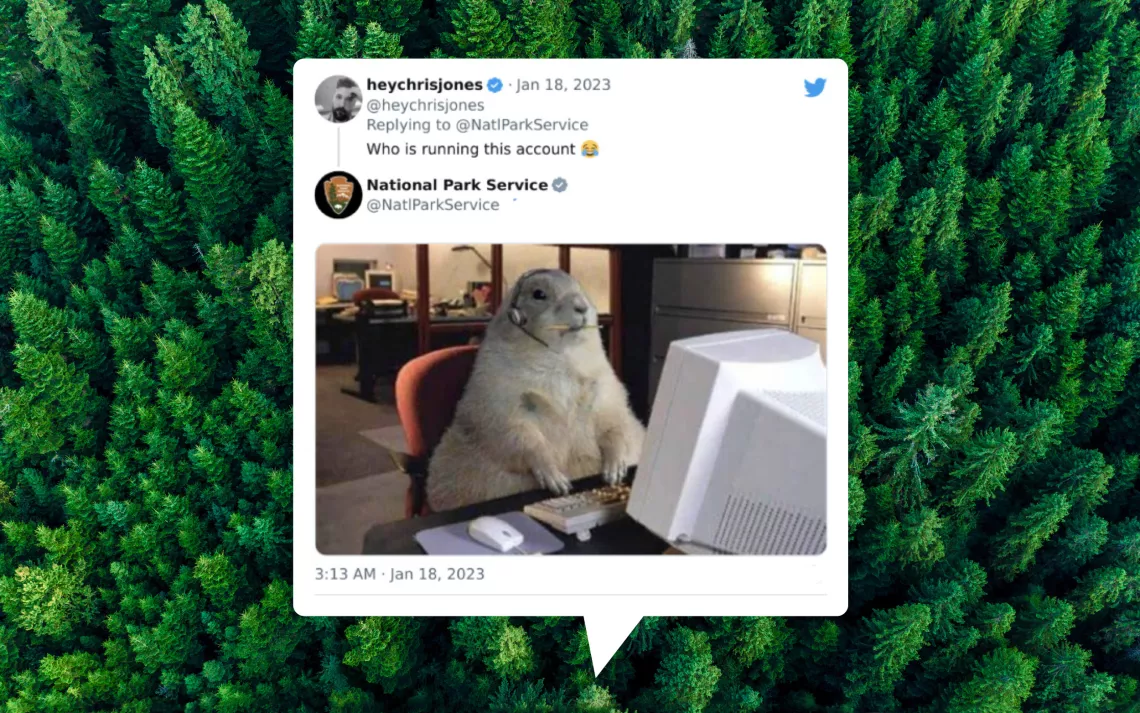Why Did Public-Land Agencies Get Snarky on Social Media?
"Who’s running this account?” Environmental agencies tap into new audiences by speaking their language.

Background: Niko_Cingaryuk/iStock / Tweet: @NatlParkService
How is singer Kate Bush like Washington State’s Department of Natural Resources’ tsunami evacuation plan? Both want you to run up that hill.
The social media team at the WADNR has joined a growing club of environmental and public-land agencies that have found their niche on social media in educating a new public about their work by using the language of the internet. Agencies from the National Park Service to the Oklahoma Department of Wildlife Conservation have adopted the communication style many of us are used to seeing online to create content that both educates and entertains.
kate bush us during a tsunami
— Washington State Dept. of Natural Resources (@waDNR) July 8, 2022
🤝
encouraging you to
run up that hill
“People are interested in the work that we do,” said Rachel Terlep, the senior social media manager at WADNR. “We just have to draw them in with some flashiness and goofiness.”
The trick is to use sly internet humor and memes to draw in audiences and slip in some educational messaging. “If you come across a bear,” the National Park Service recently warned on Twitter, “never push your slower friend down … even if you feel the friendship has run its course.” The tweet received lots of engagement due to the witty and sarcastic tone of Matt Turner, who runs the NPS’s social media accounts, but also included a link to the agency’s more serious bear safety information.
YOU are cold. They have fur.
— Oklahoma Department of Wildlife Conservation (@OKWildlifeDept) January 20, 2022
Do not let inside. pic.twitter.com/WrVIdF9mkh
“So no matter where that post traveled, that link to those tips about being safe around bears and links to our website went along with it,” he said. “That was definitely our goal with a lot of those posts—to entertain, but also always have an educational component.”
With national parks and public lands experiencing a surge in attendance during and after the pandemic, such information is especially important for those venturing into these areas for the first time. For them, social media has its perils as well. Visitors have been spotted getting dangerously close to bison in Yellowstone and teetering on the edge of cliffs at the Grand Canyon for selfies. Agencies are responding to internet-drawn visitors with, for example, selfie stations to encourage safer picture-taking and draw visitors to less crowded areas.
Achieving virality on one of these accounts isn’t just tweeting random thoughts or memes. Each platform is different, with varying follower counts, audience demographics, and algorithms. As fun as it looks, the content is carefully planned with specific goals and audiences in mind.
“We’re finding ways to take these really complex topics and break them down to reach the soccer moms on Facebook or the Gen Zs on TikTok,” said Mary Watkins, the other half of the WADNR social media team. “That individualized approach has gotten us a bigger following than I ever thought we would from DNR.”
While taking government social media in a zany new direction seems to be paying off, it does involve some upfront trust and investment from the agency itself. Traditionally, communications from government agencies have come as dry press releases, not memes from someone who also scrolls through Twitter during a slow day in the office.
“We are a science-based agency. We do take ourselves very seriously, and so, initially, it was hard for people outside of my division to really understand what we were doing,” said Kelly Adams, a communication and education supervisor with the Oklahoma Department of Wildlife Conservation. “But as time has gone on and those same people are being approached on the street about our social media, I think they’re starting to understand there is a method to the madness, that this does make sense and it has a lot of benefits for the agency.”
Adams says one of these benefits is an increased trust between the agency and the people it serves. WADNR’s Watkins agrees, and says that its audiences are also engaging with posts and asking more questions via social media that they might not otherwise feel comfortable asking or have the opportunity to ask the agency.
“That gives us the chance to hop on and answer them in an earnest way or in a funny way that really keeps them hooked and keeps that loyalty going,” she said.
NPS’s Turner says that his social media strategy is based on interacting and engaging with his audiences. He encourages audiences to share their experiences of the parks and answer questions on social media in the hopes of humanizing a 100-year-old government agency.
“I think that does allow people to connect a little bit more with this agency that they’ve known for a long time, but they’ve been able to interact with or really engage with in that more personal way,” he said.
As for the WADNR, ODWC, and NPS social media accounts, the communication departments at all of these agencies plan to continue their current strategy with humorous, educational content and explore and adapt as new social media platforms come and go. The kind of success these agencies have seen does require time and investment in social media, but their dedication has definitely paid off.
“It really does require not only a full-time person, but it requires that person to have a team of creative writers behind them,” ODWC’s Adams said. “And then it also takes a little bit of courage, but it’s well worth it in the end.”
 The Magazine of The Sierra Club
The Magazine of The Sierra Club



